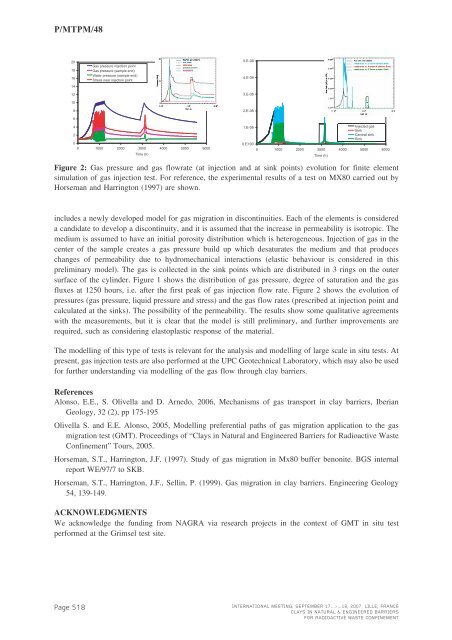Mass Transfer & Porous Media (MTPM) - Andra
Mass Transfer & Porous Media (MTPM) - Andra
Mass Transfer & Porous Media (MTPM) - Andra
Create successful ePaper yourself
Turn your PDF publications into a flip-book with our unique Google optimized e-Paper software.
P/<strong>MTPM</strong>/4820181614121086Gas pressure injection pointGas pressure (sample end)Water pressure (sample end)Stress near injection point5.E-084.E-083.E-082.E-084200 1000 2000 3000 4000 5000 6000Time (h)1.E-080.E+000 1000 2000 3000 4000 5000 6000Time (h)Injected gasSinkCentral sinkSinkFigure 2: Gas pressure and gas flowrate (at injection and at sink points) evolution for finite elementsimulation of gas injection test. For reference, the experimental results of a test on MX80 carried out byHorseman and Harrington (1997) are shown.includes a newly developed model for gas migration in discontinuities. Each of the elements is considereda candidate to develop a discontinuity, and it is assumed that the increase in permeability is isotropic. Themedium is assumed to have an initial porosity distribution which is heterogeneous. Injection of gas in thecenter of the sample creates a gas pressure build up which desaturates the medium and that produceschanges of permeability due to hydromechanical interactions (elastic behaviour is considered in thispreliminary model). The gas is collected in the sink points which are distributed in 3 rings on the outersurface of the cylinder. Figure 1 shows the distribution of gas pressure, degree of saturation and the gasfluxes at 1250 hours, i.e. after the first peak of gas injection flow rate. Figure 2 shows the evolution ofpressures (gas pressure, liquid pressure and stress) and the gas flow rates (prescribed at injection point andcalculated at the sinks). The possibility of the permeability. The results show some qualitative agreementswith the measurements, but it is clear that the model is still preliminary, and further improvements arerequired, such as considering elastoplastic response of the material.The modelling of this type of tests is relevant for the analysis and modelling of large scale in situ tests. Atpresent, gas injection tests are also performed at the UPC Geotechnical Laboratory, which may also be usedfor further understanding via modelling of the gas flow through clay barriers.ReferencesAlonso, E.E., S. Olivella and D. Arnedo, 2006, Mechanisms of gas transport in clay barriers, IberianGeology, 32 (2), pp 175-195Olivella S. and E.E. Alonso, 2005, Modelling preferential paths of gas migration application to the gasmigration test (GMT). Proceedings of “Clays in Natural and Engineered Barriers for Radioactive WasteConfinement” Tours, 2005.Horseman, S.T., Harrington, J.F. (1997). Study of gas migration in Mx80 buffer benonite. BGS internalreport WE/97/7 to SKB.Horseman, S.T., Harrington, J.F., Sellin, P. (1999). Gas migration in clay barriers. Engineering Geology54, 139-149.ACKNOWLEDGMENTSWe acknowledge the funding from NAGRA via research projects in the context of GMT in situ testperformed at the Grimsel test site.Page 518INTERNATIONAL MEETING, SEPTEMBER 17...>...18, 2007, LILLE, FRANCECLAYS IN NATURAL & ENGINEERED BARRIERSFOR RADIOACTIVE WASTE CONFINEMENT
















